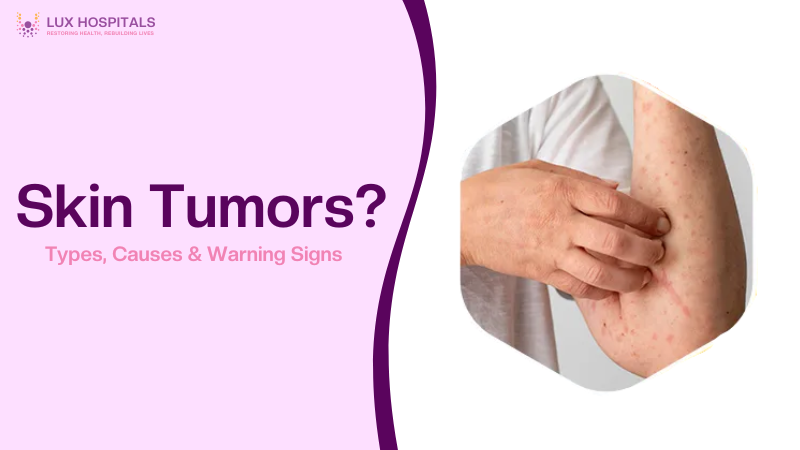Understanding Skin Tumors: Types, Causes & Warning Signs

Uncontrolled cell proliferation causes abnormal growths known as skin tumors to form on the skin. Some can be malignant and potentially fatal, while others are benign. Understanding the different types, causes, and symptoms is key to early diagnosis and treatment. Many skin tumors can be managed successfully through medical or surgical therapies if detected early. This article explores various types of skin tumors, what causes them, warning signs to watch for, and when to seek help.
What Are Skin Tumors?
A skin tumor is a lump, bump, or growth on the skin that may be benign (non-cancerous) or malignant (cancerous). These growths result from abnormal cell development and can appear anywhere in the body. Depending on the type and underlying cause, they vary in shape, size, color, and texture.
Benign tumors, such as lipomas or seborrheic keratoses, typically don’t spread or become dangerous. Malignant skin tumors, like basal cell carcinoma or melanoma, have the potential to invade surrounding tissue and spread to other parts of the body.
Common Types of Skin Tumors
There are many types of skin tumors, each with different characteristics and risk levels. Some of the most common include.
1. Benign Tumors
- Seborrheic Keratosis: These waxy, wart-like growths are harmless and typically appear in older adults.
- Soft, fatty lumps that develop beneath the skin are called lipomas. They are slow-growing and non-cancerous.
- Dermatofibromas: Firm, reddish-brown nodules often caused by minor skin injuries.
2. Pre-cancerous Lesions
- Actinic Keratosis: Scaly or crusty patches caused by sun damage. The development of squamous cell carcinoma may occur if untreated.
3. Malignant Tumors
- Melanoma: The most dangerous skin tumor, known for spreading quickly. Early detection is critical for survival.
- Basal Cell Carcinoma (BCC): The most common skin cancer. BCCs rarely spread but can damage surrounding tissue.
- Squamous Cell Carcinoma (SCC): A more aggressive cancer that can metastasize if not treated.
What Causes Skin Tumors?
Skin tumors develop when skin cells multiply abnormally due to DNA mutations. These mutations can result from a variety of risk factors, including
- Excessive Sun Exposure: Ultraviolet (UV) rays from tanning beds or the sun can harm skin cells’ DNA.
- Genetics: A family history of skin tumors increases your risk.
- Weakened Immune System: Conditions like HIV or treatments like chemotherapy make it harder for the body to fight off abnormal cells.
- Chemical Exposure: Extended contact with some substances can trigger skin cell mutations.
Even though some people are more genetically predisposed, environmental factors often play a significant role.
Warning Signs of a Skin Tumor
Spotting a skin tumor early can make a significant difference in treatment outcomes. Warning signs include:
- A new lump or bump on the skin
- A sore that doesn’t heal
- Changes in an existing mole (size, shape, color)
- Itching, bleeding, or crusting lesions
- Asymmetry or irregular borders in skin growth
The ABCDE rule asymmetry, border irregularity, color variation, diameter over 6mm, and evolving can help identify malignant melanomas early.
Diagnosis and Treatment of Skin Tumors
Diagnosis typically involves a physical examination followed by a biopsy to confirm whether the growth is benign or malignant. Imaging tests may also be used in some cases.
Treatment options depend on the type and stage of the skin tumor and include
- Surgical Removal: The most common approach for both benign and malignant tumors.
- Cryotherapy: Freezing off precancerous lesions like actinic keratosis.
- Topical Medications: Used for superficial cancers and precancerous spots.
- Radiation or Chemotherapy: For aggressive or spreading cancers.
- Immunotherapy: Beneficial for advanced melanoma cases.
Prevention Tips for Skin Tumors
Preventing skin tumors starts with protecting your skin:
- Use sunscreen daily (SPF 30 or higher)
- In the sun, put on helmets and protective clothes.
- Avoid tanning beds
- Examine your skin monthly for changes
- Visit a dermatologist annually for a full-body skin check
Making little lifestyle adjustments can significantly lower your risk of getting skin tumors.
Conclusion
Knowing skin tumor types, causes, and symptoms can help detect potential problems early. While not all skin tumors are dangerous, some can be life-threatening if ignored. Regular skin checks, sun protection, and early treatment are essential to minimize risk. Don’t wait to seek help if you notice any unusual skin changes—early diagnosis can make all the difference in outcomes. Consult a specialist promptly if you see anything new or changing on your skin.
Prevention and awareness are your best defenses against serious complications. With the right care, many skin tumors can be effectively treated or even avoided altogether.
Frequently Asked Questions
Melanoma, squamous, and basal cell carcinoma are the most prevalent varieties. Basal cell carcinoma is the most frequent but least dangerous. Melanoma is rare but can be deadly if not caught early.
In most cases, benign skin tumors do not become cancerous. However, specific precancerous lesions, like actinic keratosis, can develop into squamous cell carcinoma if treatment is not received.
Signs of cancerous skin tumors include rapid growth, changes in color or shape, bleeding, or irregular borders. Only a biopsy can confirm a diagnosis, so consult a dermatologist if unsure.
Doctors diagnose skin tumors by performing a physical exam and a skin biopsy. Imaging examinations may occasionally also reveal whether the malignancy has spread. If cancer is suspected, further tests may be done to see if it has spread.




















